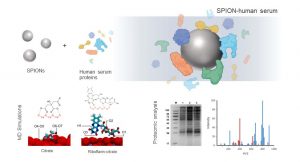This work, protein coronas of bare, citrate-coated, and Rf-coated SPIONs formed with human serum (HS) were studied by proteomic analysis to identify and quantify the nanoparticle–protein interaction. The results were compared with the FBS-derived coronas to understand the differences in the protein corona formation from different serum origins. In addition, we used molecular dynamic simulation to explain the interactions of the SPIONs with riboflavin carrier protein (RCP), which is a target protein for the Rf-SPIONs, were also studied. The simulation results also showed the influence of surface hydrophilicity of the SPIONs on the RCP interaction. The combined data from proteomic and simulation analyses suggested a way to improve the Rf ligand to enhance the interaction with RCP and reduce the interactions with the serum proteins, which could enhance the specific cellular interactions and improve the Rf-SPIONs as MRI contrast agents for breast cancer.
Reference
Mekseriwattana W, Phanchai W, Thiangtrongjit T, Reamtong O, Puangmali T, Wongtrakoongate P, Roig A, Katewongsa KP. Proteomic Analysis and Molecular Dynamics Simulation of Riboflavin-Coated Superparamagnetic Iron Oxide Nanoparticles Reveal Human Serum-Derived Protein Coronas: Implications as Magnetic Resonance Imaging Contrast Agents.
ACS Applied Nano Materials 2023 6 (15), 13952-13964.
| Relevant SDGs | |
|---|---|
| BC investigator | |
 Assoc. Prof. Kanlaya Prapainop Katewongsa Assoc. Prof. Kanlaya Prapainop Katewongsa |
|

